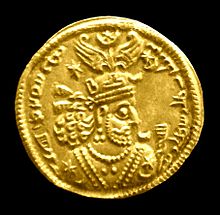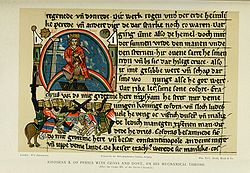- Khosrau II
-
Khosrau II King of Persia 
Gold coin with the image of Khosrau IIReign Persia: 590 AD to 628 AD Born unknown Birthplace Ctesiphon Died February 28, 628 Place of death Ctesiphon Predecessor Hormizd IV Kavadh II Successor Kavadh II as King of Persia and Byzantine Emperor Heraclius as King of Kings Consort Shirin, Miriam/Maria Father Hormizd IV Religious beliefs Zoroastrianism Khosrau II (Khosrow II, Chosroes II, or Xosrov II in classical sources, sometimes called Parvez, "the Ever Victorious" – (in Persian: خسرو پرویز), was the twenty-second Sassanid King of Persia, reigning from 590 to 628. He was the son of Hormizd IV (reigned 579–590) and the grandson of Khosrau I (reigned 531–579).
Contents
Biography
Personality and skills
Historian Muhammad ibn Jarir al-Tabari describes him as:
Excelling most of the other Persian kings in bravery, wisdom and forethought, and none matching him in military might and triumph, hoarding of treasures and good fortunes, hence the epithet Parviz, meaning victorious.[1]
According to legend, Khosrau had a shabestan in which over 3,000 concubines resided.[1]
Ascension to the throne
Khosrau II was raised to the throne by the same magnates who had rebelled against his father Hormizd IV. Soon after being crowned, Khosrau had his father blinded, then executed. However, at the same time, General Bahram Chobin had proclaimed himself King Bahram VI (590–591), exemplifying Khosrau's difficulty in maintaining control of his kingdom.
The war with the Byzantine Empire, which had begun in 571, had not yet come to an end. So, Khosrau II fled to Syria, and, subsequently, to Constantinople, where the Emperor Maurice (582–602) agreed to assist Khosrau in regaining his throne. In return, the Byzantines would re-gain sovereignty over the cities of Amida, Carrhae, Dara and Miyafariqin. Furthermore, Persia was required to cease intervening in the affairs of Iberia and Armenia, effectively ceding control of Lazistan to the Byzantines.[2][3]
A large percentage of the leading bureaucrats, administrators, governors, and military commanders, along with the majority part of the Persian military, acknowledged Khosrau II as the King of Persia. Therefore, in 591, Khosrau returned to Ctesiphon with Byzantine aid and subsequently defeated Bahram VI at the Battle of Blarathon. Bahram fled to the Turks of Central Asia, and settled in Ferghana.[4] However, a few years later, he was killed by a hired assassin send by Khosrau II.[5] Then, peace with Byzantium was concluded. For his aid, Maurice received the Persian provinces of Armenia and Georgia, and received the abolition of the subsidies which had formerly been paid to the Persians.
Military exploits and early victories
See also: Byzantine–Sassanid War of 602–628Towards the beginning of his reign, Khosrau II favoured the Christians. However, when in 602 Maurice was murdered by his General Phocas (602–610), who usurped the Roman (Byzantine) throne, Khosrau launched an offensive against Constantinople, ostensibly to avenge Maurice's death, but clearly his aim included the annexation of as much Byzantine territory as was feasible. His armies invaded and plundered Syria and Asia Minor, and in 608 advanced into Chalcedon.
In 613 and 614, Damascus and Jerusalem were besieged and captured by General Shahrbaraz, and the True Cross was carried away in triumph. Soon afterwards, General Shahin marched through Anatolia, defeating the Byzantines numerous times, and then conquered Egypt in 618. The Byzantines could offer but little resistance, as they were torn apart by internal dissensions, and pressed by the Avars and Slavs, who were invading the Empire from across the Danube River.
Khosrau's forces also invaded Taron at times during his reign.[6]
Richard Nelson Frye speculates that one major mistake of Khosrau II, which was to have severe consequences in the future, was the capture, imprisonment, and execution of Nu'aman III, King of the Lakhmids of Al-Hira, in approximately 600, presumably because of the failure of the Arab king to support Khosrau during his war against the Byzantines. (Nu'aman was crushed by elephants according to some accounts.) Afterwards the central government took over the defense of the western frontiers to the desert and the buffer state of the Lakhmids vanished. This ultimately facilitated the invasion and loss of Lower Iraq less than a decade after Khosrau's death by the forces of the Islamic Caliphs.[7]
Turn of tides
Ultimately, in 622, the Byzantine Emperor Heraclius (who had succeeded Phocas in 610 and ruled until 641) was able to take the field with a powerful force. In 624, he advanced into northern Media, where he destroyed the great fire-temple of Ganzhak (Gazaca). Several years later, in 626, he captured Lazistan (Colchis). Later that same year, Persian general Shahrbaraz advanced to Chalcedon and attempted to capture Constantinople with the help of Persia's Avar allies. His maneuver failed as his forces were defeated, and he withdrew his army from Anatolia later in 628.
Following the Khazar invasion of Transcaucasia in 627, Heraclius defeated the Persian army at the Battle of Nineveh and advanced towards Ctesiphon. Khosrau II fled from his favourite residence, Dastgerd (near Baghdad), without offering resistance. Meanwhile, some of the Persian grandees freed his eldest son Kavadh II (he ruled briefly in 628), whom Khosrau II had imprisoned, and proclaimed him King on the night of 23–4 February, 628.[8] Four days afterwards, Khosrau II was murdered in his palace. Meanwhile, Heraclius returned in triumph to Constantinople and in 629 the True Cross was returned to him and Egypt evacuated, while the Sassanid Empire, from the apparent greatness which it had reached ten years ago, sank into hopeless anarchy. It was overtaken by the armies of the first Islamic Caliphs beginning in 634.
In art
The battles between Heraclius and Khosrau are depicted in a famous early Renaissance fresco by Piero della Francesca, part of the History of the True Cross cycle in the church of San Francesco, Arezzo. Khosrau has been painted in the Ajanta Frescoes.
Khosrau IIPreceded by
Hormizd IVGreat King (Shah) of Persia
590–628Succeeded by
Kavadh IISee also
- Shirin Beloved wife of Khosrau
- Khosrow and Shirin A Persian love story depicting a ménage à trois between Khosrau and Shirin as king and queen, and Farhad as Shirin's lover
- Barbad Khosrau's favorite court musician
- Shabdiz Khosrau's highly admired horse
- Non-Muslim interactants with Muslims during Muhammad's era
- Muqawqis, Ruler of Alexandria
- Behistun inscription
- Behistun palace
- Babai the Great
References
 Chisholm, Hugh, ed (1911). "Chosroes". Encyclopædia Britannica (11th ed.). Cambridge University Press.
Chisholm, Hugh, ed (1911). "Chosroes". Encyclopædia Britannica (11th ed.). Cambridge University Press.- Edward Walford, translator, The Ecclesiastical History of Evagrius: A History of the Church from AD 431 to AD 594, 1846. Reprinted 2008. Evolution Publishing, ISBN 978-1-889758-88-6. [1] — a primary source containing detailed information about the early reign of Khosrau II and his relationship with the Romans.
- Continuité des élites à Byzance durante les siècles obscurs. Les princes caucasiens et l'Empire du VIe au IXe siècle, 2006
Footnotes
- ^ a b Muhammad ibn Jarir al-Tabari, History of the Prophets and Kings, vol. 2
- ^ Dinavari, Akhbâr al-tiwâl, pp. 91-92;
- ^ Ferdowsi in Shahnameh affirms the same conditions put forth by Maurice.
- ^ Gumilev L.N. Bahram Chubin, p. 229 - 230.
- ^ Usanova M. Ismoil Somonii waqfnomasi, p. 29.
- ^ Armenian Folk Literature, John Mamikonean's History of Taron
- ^ Richard Nelson Frye, The History of Ancient Iran, p 330.
- ^ According James Howard-Johnston in his notes to The Armenian History attributed to Sebeos (trans. R.W. Thomson; Liverpool: University Press, 1999), p. 221
Ardashir I (224–241) · Shapur I (241–272) · Hormizd I (272–273) · Bahram I (273–276) · Bahram II (276–293) · Bahram III (293) · Narseh (293–302) · Hormizd II (302–309) · Adhur Narseh (309) · Shapur II (309–379) · Ardashir II (379–383) · Shapur III (383–388) · Bahram IV (388–399) · Yazdegerd I (399–420) · Bahram V (420–438) · Yazdegerd II (438–457) · Hormizd III§ (457–459) · Peroz I (457–484) · Balash (484–488) · Kavadh I (488–496) · Djamasp (496–498) · Kavadh I (498–531) · Khosrau I (531–579) · Hormizd IV (579–590) · Bahram VI Chobin§ (590–591) · Khosrau II (591–628) · Bistam (Sassanid king)§ (591–595) · Hormizd V§ (593) · Kavadh II (628) · Ardashir III (628–630) · Shahrbaraz§ (630) · Khosrau III§ (630) · Borandukht (630–631) · Azarmidokht (631) · Hormizd VI (631–632) · Khosrau IV (631–633) · Yazdegerd III (632–651) · Peroz II (pretender)§ usurpers or rival claimants
Categories:- 590 births
- 628 deaths
- Sassanid dynasty
- Pre-Islamic heritage of Iran
- One Thousand and One Nights characters
- 7th-century monarchs in the Middle East
- 6th-century monarchs in the Middle East
Wikimedia Foundation. 2010.




